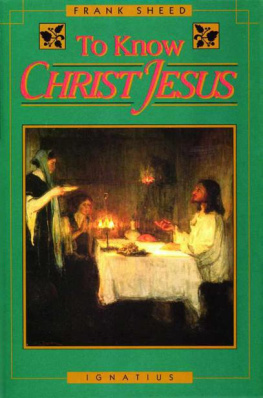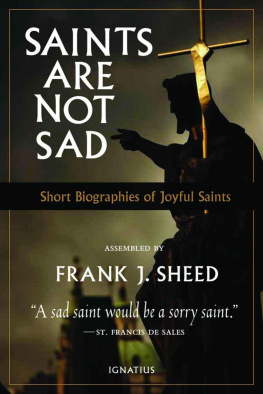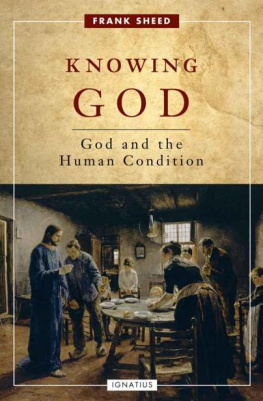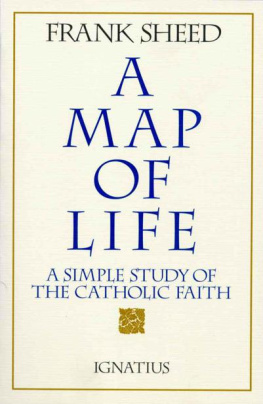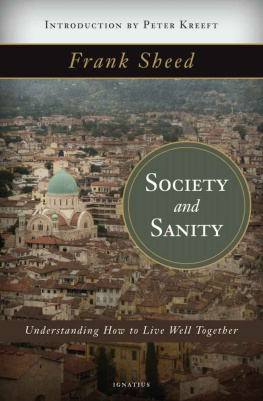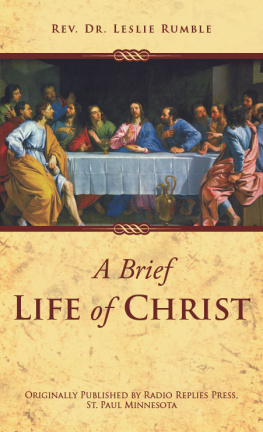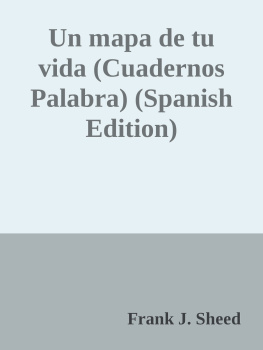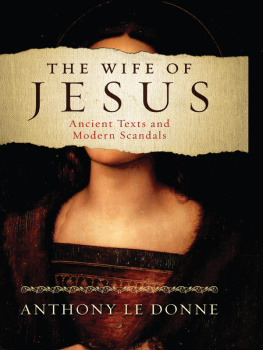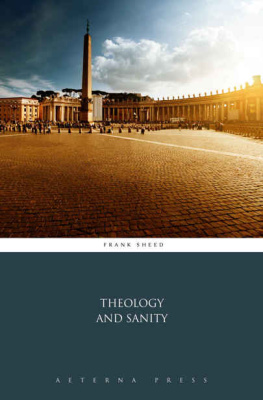To Know
C HRIST J ESUS
This is eternal life: that they may know
thee, the only true God, and Jesus Christ
whom thou hast sent .
(Jn 17:3)
To Know
C HRIST J ESUS
F. J. SHEED
IGNATIUS PRESS SAN FRANCISCO
Original edition 1962 Sheed & Ward, Inc.
1980 F. J. Sheed
Published with ecclesiastical approval
All rights reserved
Cover art: Christ at the Home of Mary and Martha
by Henry Ossawa Tanner, 1859-1937, Purchase, 07.3
Reproduced with the permission of The Carnegie Museum of Art
Cover design by Riz Boncan Marsella
Published in 1992 by Ignatius Press
ISBN 0-89870-419-7
Library of Congress Catalogue number 92-71935
Printed in the United States of America
Contents
PART ONE: THE FIRST THIRTY YEARS
PART TWO: THE PUBLIC LIFE
PART THREE: REDEMPTION
Preface to the 1980 Edition:
EIGHTEEN YEARS LATER
I had finished writing this book before the first meeting of Pope Johns Vatican Council. I remember talking at the time to Cardinal Gilroy of Sydney. He said the Pope had told him that the Council would be over in three months, so carefully had the agenda been prepared. It lasted four years; its first act had been to reject the so carefully prepared agenda. In the years that followed I never reminded the cardinal of this minor flaw in papal infallibility.
It was a different world then. I had forgotten how different. The feel of the period is almost impossible to recall. A kindly reviewer of the books first edition found it too cozy. Reviewing it today for this new edition I know what he meant. Coziness was the precise word for the generality of us. We were in the Ark; outside was the flood. There was a kind of innocence about us. The poet Gray, writing a couple of centuries earlier, might have been writing about the Catholic laity as we were then:
Alas, regardless of their doom,
The little victims play.
Only the rare ones sensed the explosion to come. I hadnt a notion that within five years I should be writing Is It the Same Church ?
Changes came, a whirl of them, which to many seemed like rendings. The Catholic Church is in process of restructuring, and we do not see the end of it.
Indeed all the major churches of the West have been having their own rendings and restructurings. Pope John had said splendidly of the other Christian communions: They bear the name of Christ on their forehead: which means that they bear the Sign of the Cross. The Cross is not cozy.
According to our temperament we can either be exhilarated by the rate of change and wish it were faster; or feel we are losing all we have ever valued. But temperament settles nothing. The test of every change is whether it brings Christ closer, and this we cannot judge unless we know him as he lived and taught among us. That is why books of this present sort are more needed now than eighteen years ago..
R. J. S.
1979
FOREWORD
This book is not a biography. There is too much of Christs life upon which no fight falls for us; and the accounts we have of the two or three luminous years are written by men not biographically-minded. It is not a Gospel commentary either, though written in light shed upon the texts by many scholars. My concern with the Gospels is to see the Face which through all the centuries has looked out from them upon men. The object is not to prove something but to meet Someonethat we should know Christ Jesus, know him as one person may know another. As Christians we love him, try to live by his law, would think it a glory to die for him. But how well do we know him?
The creeds, concerned only to give us a kind of blueprint of our redemption, go straight from his birth to his Passion and death... born of the Virgin Mary. He suffered under Pontius Pilate, says the Apostles Creed;... made man. For our sake he was crucified under Pontius Pilate, says the Nicene. That summarizes the position for a great manya blaze of light about his birth, another about his death, but dimness in between. An occasional miracle stands out, a few parables, but there is no shape to the knowledge, no depth or connection. We seem curiously incurious about the life of One who is the life of our life.
Perhaps I exaggerate our general un-knowledge. I hope I do. Here are three quick tests. At the Transfiguration Moses and Elijah spoke with Christ: What were they talking about? Againonce, once only, we are told that our Lord was joyful: one would expect that episode to stand out like a star: Does it for most of us? Once moreone has heard unbelievers asking why we do not drop the cruel doctrine of hell and return to the simple, loving teaching of Christ in the Sermon on the Mount. It is the rarest thing to find a layman making the obvious comment that in that sermon our Lord warns his hearers of hell five separate times: nowhere else does he speak so much of hell.
Not to know these things means that we have not followed Jesus through the years of his teaching. If we would know him as he is, the infancy and the Passion are not enough. The infancy is not enough, since one baby looks much like another. The Passion is luminous, but with a special light. For by then he had yielded himself up as a victim, and we feel him different. For full knowledge we need to see him in the public ministry as well, for only then do we see him simply being himselfwalking the roads of Palestine, meeting with his friends, answering his enemies. The difference is focused for us in the matter of Judas. In Gethsemane, as Judas kisses him in betrayal, Christ says, Friend, what have you come for? That was not at all the way he spoke of him in CapernaumHave I not chosen you twelve, and one of you is a devil?
Not to know the two years or so of the public ministry, not to have lived through every incident of it, is not to know God-made-man as he dwelt among us. There are those who regard this kind of knowledge as an extra, interesting but not essential. Our salvation, they remind us, was not wrought by what he did in those years. It is by his death and Resurrection that we are saved, it is in the risen Christ that we now live.
But it is the Christ of the earthly life who is now at the right hand of the Fatherthat Christ, now risen, in whom we live. And, in any event, our salvation is not all that matters in religion, or even what matters most. That was the mistake of the old type of Bible Christian: he was saved, the rest was mere theology. His fellow Bible Christians might believe that God was three Persons or one only, that Christ was God and man or man onlythese were secondary, the sole primary being to accept Christ as ones personal Savior. It made the self unhealthily central, unchristianly central. This is eternal life: to know thee, the one true God, and Jesus Christ, whom thou hast sent (Jn 17:3).
To know Christ Jesus: if we do not know him as he lived among us, acted and reacted and suffered among us, we risk not knowing him at all. For we cannot see him at the right hand of the Father as we can see him in Palestine. And we shall end either in constructing our own Christ, image of our own needs or dreams, or in having no Christ but a shadow and a name. Either way the light he might shed is not shed for uslight upon himself, light upon God.
For the kind of ignoring I have in mind cuts off a vast shaft of light into the being of God. The truth Christ is God is a statement not only about Christ but about God. Without it, we could still know of God, certainly, but in his own nature onlyinfinite, omnipotent, creating from nothing, sustaining creation in being. It would be a remote kind of knowledge, for of none of these ways of being or doing have we any personal experience. In Christ Jesus we can see God in our nature, experiencing the things we have experienced, coping with situations we have to cope with. Thereby we know God as the most devout pagan cannot know him.
Next page
